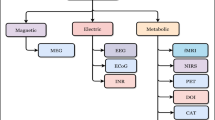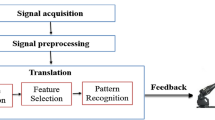Abstract
Deep learning is closely related to theories of brain development. Brain-Computer Interface (BCI) is the latest development in human–computer interaction (HCI). The BCI reads brain signals from different areas of the human brain and translates these signals into commands that can be controlled through the computer applications. BCI technology is effective in the field of human emotions recognition, with high accuracy using EEG signals. When the brain signals are collected and analyzed using deep learning algorithms, it helps in diagnosing diseases and in distinguishing between physical and psychological diseases, which is helpful in making a correct medical decision. The combination of feature selection methods and classification algorithms serves to recognize emotion more accurately from EEG signals. Each of these algorithms has degree of accuracy and unique characteristics. In this paper, we have reviewed and discussed the related studies on BCI technology that are most concerned with classification of emotions through EEG signals. In addition, we have reviewed the methods of collecting signals and feature extraction from EEG datasets. The paper also discusses the main challenges faced in emotion recognition using EEG. We have reviewed several recent studies are classified based on the techniques used in the emotion recognition process. The results show a clear increase in research related to emotion recognition as an important area of investigation, and a diversity of techniques being used to extract and classify features. After discussing the challenges, we found that given the state of technological development, the interconnection between technology and medicine will generate a tremendous volume of applied solutions in future, contributing to the development of research in health informatics systems. A comparison of the recent studies in this field has been conducted, and we deduce the wide variety of techniques used to detect emotion and the increasingly accurate results.
Access this chapter
Tax calculation will be finalised at checkout
Purchases are for personal use only
Similar content being viewed by others
References
Pandey, P., Seeja, K.R.: Subject independent emotion recognition from EEG using VMD and deep learning. Journal of King Saud University-Computer and Information Sciences (2019). https://doi.org/10.1016/j.jksuci.2019.11.003
Liu, J., Meng, H., Li, M., Zhang, F., Qin, R., Nandi, A.K.: Emotion detection from EEG recordings based on supervised and unsupervised dimension reduction. Concurr. Comput. 30(23), 1–13 (2018). https://doi.org/10.1002/cpe.4446
Korde, K.S., Paikrao, P.L., Jadhav, N.S.: Analysis of EEG signals and biomedical changes due to meditation on brain by using ICA for feature extraction. In: 2018 Second International Conferences on Intelligent Computing Control System. Iciccs, pp. 1479–1484 (2018)
Thammasan, N., Thammasan, K., Moriyama, K., Fukui, K., Numao, M.: Familiarity effects in EEG-based emotion recognition. Brain Inform. 4(1), 39–50 (2017). https://doi.org/10.1007/s40708-016-0051-5
Khalili Ardali, M., Rana, A., Purmohammad, M., Birbaumer, N., Chaudhary, U.: Semantic and BCI-performance in completely paralyzed patients: possibility of language attrition in completely locked in syndrome. Brain Lang. 194(8), 93–97 (2019). https://doi.org/10.1016/j.bandl.2019.05.004
Mohammadpour, M., Hashemi, S.M.R., Houshmand, N.: Classification of EEG-based emotion for BCI applications. In: 7th Conferences Artificial Intelligence Robotics IRANOPEN 2017, pp. 127–131 (2017). https://doi.org/10.1109/rios.2017.7956455
Bontchev, B.: Adaptation in affective video games: a literature review. Cybern. Inf. Technol. 16(3), 3–34 (2016). https://doi.org/10.1515/cait-2016-0032
Abbasi-Asl, R., Keshavarzi, M., Chan, D.Y.: Brain-Computer interface in virtual reality. In: International IEEE/EMBS Conference on Neural Engineering NER, vol. 2019, pp. 1220–1224 (2019). https://doi.org/10.1109/ner.2019.8717158
Al-Nafjan, A., Hosny, M., Al-Wabil, A., Al-Ohali, Y.: Classification of human emotions from Electroencephalogram (EEG) signal using deep neural network. Int. J. Adv. Comput. Sci. Appl. 8(9), 419–425 (2017). https://doi.org/10.14569/ijacsa.2017.080955
Thejaswini, S., Ravikumar, K.M., Jhenkar, L., Natraj, A., Abhay, K.K.: Analysis of EEG based emotion detection for DEAP and SEED-IV databases using SVM 208 II. Lit. Rev. 1, 207–211 (2019)
Ullah, H., Uzair, M., Mahmood, A., Ullah, M., Khan, S.D., Cheikh, F.A.: Internal emotion classification using EEG signal with sparse discriminative ensemble. IEEE Access 7(3), 40144–40153 (2019). https://doi.org/10.1109/ACCESS.2019.2904400
Santamaria-Granados, L., Munoz-Organero, M., Ramirez-Gonzalez, G., Abdulhay, E., Arunkumar, N.: Using deep convolutional neural network for emotion detection on a physiological signals dataset (AMIGOS). IEEE Access 7, 57–67 (2019). https://doi.org/10.1109/ACCESS.2018.2883213
Alarcão, S.M., Fonseca, M.J.: Emotions recognition using EEG signals: a survey. IEEE Trans. Affect. Comput. 10(3), 374–393 (2019). https://doi.org/10.1109/TAFFC.2017.2714671
Wei, Y., Wu, Y., Tudor, J.: A real-time wearable emotion detection headband based on EEG measurement. Sens. Actuators Phys. 263, 614–621 (2017). https://doi.org/10.1016/j.sna.2017.07.012
Mehndi, S.H.: Emotion Recognition using EEG Signal and Deep Learning Approach (8) (2019)
Wang, K.Y., Ho, Y.L., De Huang, Y., Fang, W.C.: Design of intelligent EEG system for human emotion recognition with convolutional neural network. In: Proceedings 2019 IEEE International Conference on Artificial Intelligence Circuits and Systems AICAS 2019, pp. 142–145 (2019). https://doi.org/10.1109/aicas.2019.8771581
Zhuang, N., Zeng, Y., Yang, K., Zhang, C., Tong, L., Yan, B.: Investigating patterns for self-induced emotion recognition from EEG signals. Sens. (Switzerland) 18(3), 1–22 (2018). https://doi.org/10.3390/s18030841
Ay, B., et al.: Automated depression detection using deep representation and sequence learning with EEG signals. J. Med. Syst. 43(7), 1–12 (2019). https://doi.org/10.1007/s10916-019-1345-y
Gonzalez, H.A., Yoo, J., Elfadel, I.A.M.: EEG-based emotion detection using unsupervised transfer learning. In: Proceedings Annual International Conference of the IEEE Engineering in Medicine and Biology Society EMBS, pp. 694–697 (2019). https://doi.org/10.1109/embc.2019.8857248
Deng, Y., Wu, F., Du, L., Zhou, R., Cao, L.: EEG-based identification of latent emotional disorder using the machine learning approach. In: Proceedings 2019 IEEE 3rd Information Technology, Networking, Electronic and Automation Control Conference ITNEC 2019, pp. 2642–2648 (2019). https://doi.org/10.1109/itnec.2019.8729424
Thejaswini, S., Ravi Kumar, K.M., Rupali, S., Abijith, V.: EEG based emotion recognition using wavelets and neural networks classifier. In: SpringerBriefs Applications of Science and Technology, no. 9789811066979, pp. 101–112 (2018). https://doi.org/10.1007/978-981-10-6698-6_10
Liu, S., et al.: Improve the generalization of the cross-task emotion classifier using EEG based on feature selection and SVR. In: 2019 IEEE 10th International Conference on Awareness Science and Technology iCAST 2019, pp. 1–5 (2019). https://doi.org/10.1109/icawst.2019.8923256
Mert, A., Akan, A.: Emotion recognition from EEG signals by using multivariate empirical mode decomposition. Pattern Anal. Appl. 21(1), 81–89 (2018). https://doi.org/10.1007/s10044-016-0567-6
George, F.P., Shaikat, I.M., Ferdawoos Hossain, P.S., Parvez, M.Z., Uddin, J.: Recognition of emotional states using EEG signals based on time-frequency analysis and SVM classifier. Int. J. Electr. Comput. Eng. 9(2), 1012–1020 (2019). https://doi.org/10.11591/ijece.v9i2
Girardi, D., Lanubile, F., Novielli, N.: Emotion detection using noninvasive low cost sensors. In: 2017 7th International Conference on Affective Computing and Intelligent Interaction ACII 2017, vol. 2018, no. 1, pp. 125–130 (2018). https://doi.org/10.1109/acii.2017.8273589
Zamanian, H., Farsi, H.: A new feature extraction method to improve emotion detection using EEG signals. Electron. Lett. Comput. Vis. Image Anal. 17(1), 29–44 (2018). https://doi.org/10.5565/rev/elcvia.1045
Ozdemir, M.A., Degirmenci, M., Guren, O., Akan, A.: EEG based emotional state estimation using 2-D deep learning technique. In: TIPTEKNO 2019 Tip Teknol. Kongresi, pp. 1–4 (2019) https://doi.org/10.1109/tiptekno.2019.8895158
Bota, P.J., Wang, C., Fred, A.L.N., Placido Da Silva, H.: A review, current challenges, and future possibilities on emotion recognition using machine learning and physiological signals. IEEE Access 7, 140990–141020 (2019). https://doi.org/10.1109/ACCESS.2019.2944001
Author information
Authors and Affiliations
Editor information
Editors and Affiliations
Rights and permissions
Copyright information
© 2021 The Author(s), under exclusive license to Springer Nature Switzerland AG
About this paper
Cite this paper
Algarni, M., Saeed, F. (2021). Review on Emotion Recognition Using EEG Signals Based on Brain-Computer Interface System. In: Saeed, F., Mohammed, F., Al-Nahari, A. (eds) Innovative Systems for Intelligent Health Informatics. IRICT 2020. Lecture Notes on Data Engineering and Communications Technologies, vol 72. Springer, Cham. https://doi.org/10.1007/978-3-030-70713-2_42
Download citation
DOI: https://doi.org/10.1007/978-3-030-70713-2_42
Published:
Publisher Name: Springer, Cham
Print ISBN: 978-3-030-70712-5
Online ISBN: 978-3-030-70713-2
eBook Packages: Intelligent Technologies and RoboticsIntelligent Technologies and Robotics (R0)




